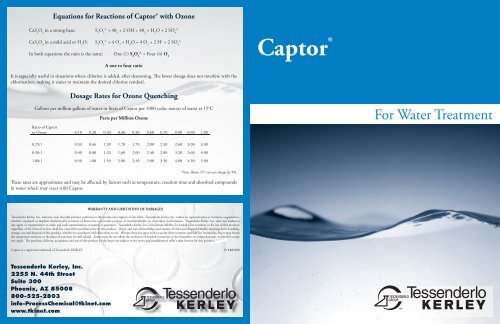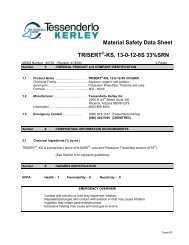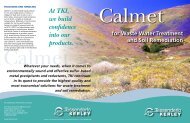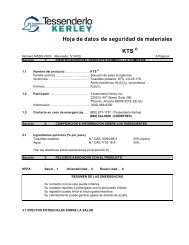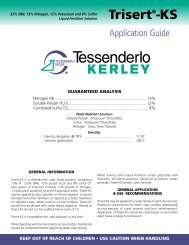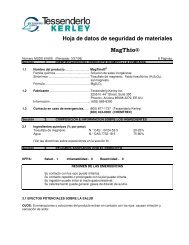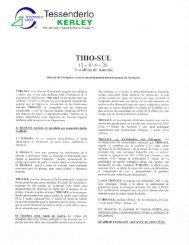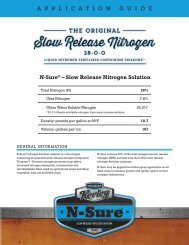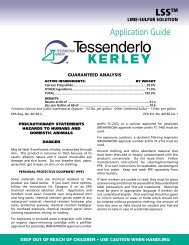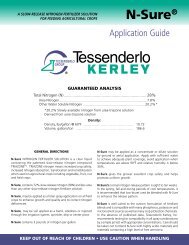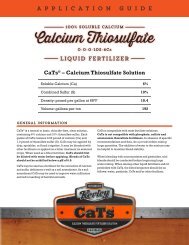Captor® Brochure - Tessenderlo Kerley
Captor® Brochure - Tessenderlo Kerley
Captor® Brochure - Tessenderlo Kerley
Create successful ePaper yourself
Turn your PDF publications into a flip-book with our unique Google optimized e-Paper software.
Equations for Reactions of Captor® with Ozone<br />
CaS 2<br />
O 3<br />
in a strong base: S 2<br />
O 3<br />
2-<br />
+ 40 3<br />
+ 2 OH = 40 2<br />
+ H 2<br />
O + 2 SO 4<br />
2-<br />
CaS 2<br />
O 3<br />
in a mild acid or H 2<br />
O: S 2<br />
O 3<br />
2-<br />
+ 4 O 3<br />
+ H 2<br />
O = 4 O 2<br />
+ 2 H + + 2 SO 4<br />
2-<br />
In both equations the ratio is the same: One (1) S 2<br />
O 3<br />
2-<br />
= Four (4) O 3<br />
Captor ®<br />
A one to four ratio<br />
It is especially useful in situations where chlorine is added, after deozoning. The lower dosage does not interfere with the<br />
chlorination, making it easier to maintain the desired chlorine residual.<br />
Dosage Rates for Ozone Quenching<br />
Gallons per million gallons of water or liters of Captor per 1000 cubic meters of water at 15°C<br />
Parts per Million Ozone<br />
Ratio of Captor<br />
to Ozone 0.10 0.20 0.30 0.40 0.50 0.60 0.70 0.80 0.90 1.00<br />
For Water Treatment<br />
0.25:1 0.33 0.66 1.30 1.70 1.70 2.00 2.30 2.60 3.00 3.30<br />
0.50:1 0.40 0.80 1.20 1.60 2.00 2.40 2.80 3.20 3.60 4.00<br />
1.00:1 0.50 1.00 1.50 2.00 2.50 3.00 3.50 4.00 4.50 5.00<br />
*Note: Below 5°C increase dosage by 5%.<br />
These rates are approximate and may be affected by factors such as temperature, reaction time and dissolved compounds<br />
in water which may react with Captor.<br />
WARRANTY AND LIMITATION OF DAMAGES<br />
<strong>Tessenderlo</strong> <strong>Kerley</strong>, Inc. warrants only that this product conforms to the product description on the label. <strong>Tessenderlo</strong> <strong>Kerley</strong>, Inc. makes no representation or warranty or guarantee,<br />
whether expressed or implied, disclaims any warranty of fitness for a particular purpose of merchantability, or of product performance. <strong>Tessenderlo</strong> <strong>Kerley</strong>, Inc. does not authorize<br />
any agent or representative to make any such representation, warranty or guarantee. <strong>Tessenderlo</strong> <strong>Kerley</strong>, Inc.’s maximum liability for breach of its warranty or for use of this product,<br />
regardless of the form of action, shall not exceed the purchase price of this product. Buyer and user acknowledge and assume all risks and disposal liability resulting from handling,<br />
storage, use and disposal of this product, whether in accordance with directions or not. If buyer does not agree with or accept these warranty and liability limitations, buyer may return<br />
the unopened container to the place of purchase for full refund. Some states do not allow the exclusion of implied warranties or the limitation of certain damages, so the above may<br />
not apply. The purchase, delivery, acceptance and use of this product by the buyer are subject to the terms and conditions of seller's sales invoice for this product.<br />
Captor is a registered trademark of <strong>Tessenderlo</strong> KERLEY<br />
© TKI2008<br />
<strong>Tessenderlo</strong> <strong>Kerley</strong>, Inc.<br />
2255 N. 44th Street<br />
Suite 300<br />
Phoenix, AZ 85008<br />
800-525-2803<br />
info-ProcessChemical@tkinet.com<br />
www.tkinet.com
Captor® (calcium thiosulfate solution) is a relatively new product,<br />
now available to the potable water and wastewater treatment<br />
industries. Captor is a nearly odorless, colorless, non-hazardous,<br />
non-toxic solution. It is certified in accordance with ANSI NSF<br />
Standard 60 for drinking water applications.<br />
Captor is now solving a number of traditional problems for water<br />
and wastewater treatment plant operators. Tank and line heating<br />
are generally not needed, and the product presents no problem<br />
with off-gassing. In ozone destruction, Captor is more efficient<br />
and requires lower dosing rates than other chemicals.<br />
Why not modernize your treatment process with water-clear<br />
Captor? It offers several advantages over the use of alternative<br />
chemicals, including:<br />
■ A safe, non-hazardous solution ■ A less corrosive material<br />
■ No potential SO 2<br />
exposure ■ No off-gassing<br />
■ Water clear ■ Nearly odorless<br />
■ Maintains a low freezing point ■ Harder to crystallize<br />
■ Applicator friendly ■ Carrier water not required<br />
Equations for Reactions of Captor with Chlorine<br />
1. CaS 2<br />
O 3<br />
+ 2 Cl 2<br />
+ 3 H 2<br />
O ➞ 4 HCl + Ca(HSO 3<br />
) 2<br />
2. Ca(HSO 3<br />
) 2<br />
+ 2 Cl 2<br />
+ 2H 2<br />
O ➞ 4HCl + CaSO 4<br />
+ H 2<br />
SO 4<br />
3. CaS 2<br />
O 3<br />
+ 4 Cl 2<br />
+ 5 H 2<br />
O ➞ 8 HCl + CaSO 4<br />
+ H 2<br />
SO 4<br />
4. CaS 2<br />
O 3<br />
+ Cl 2<br />
+ H 2<br />
O ➞ CaSO 4<br />
+ S + 2 HCl<br />
Captor® Application Guidelines for Dechlorination<br />
In order to maximize your prospects for success and to achieve a low, cost-effective treatment, we<br />
would like to provide you with the following application guidelines:<br />
1. Process Flow Control: A simple feed pump and chlorine monitoring system is required<br />
for dechlorination with Captor. Where Sodium Bisulfite is in use, we suggest you flushout<br />
existing lines, equipment and storage tank thoroughly prior to any use of Captor.<br />
2. Dosage Ratio: Municipalities generally use a multiplier of about 1.48 pounds of Captor<br />
per pound of chlorine. This ratio has proven to be effective year-round. (Please refer to our<br />
dosage chart below for more details.)<br />
3. Chemical Mixing: Good mixing is important for cost-effective dechlorination, as it can<br />
significantly reduce the amount of Captor required for treatment.<br />
4. Contact Time: While Captor reduces chlorine instantaneously, it may still require a few<br />
minutes to bring lingering chlorine levels to zero residual. Please allow a adequate lag<br />
time for the treated effl uent to travel from the dechlorination zone to the final chlorine<br />
residual sampling point.<br />
5. Maintenance: We recommend flushing and disinfecting supply lines and day tanks at<br />
least once per year to avoid potential plugging and/or product contamination.<br />
Please note that the guidelines listed above are the basics for using Captor in dechlorination, but<br />
general guidelines are not always sufficient to ensure both effective and efficient treatment. If you<br />
experience any issues with the performance of Captor, please give us a call – we will be happy<br />
to review your application and method, and assist you in maximizing both the efficiency and<br />
effectiveness of treatment.<br />
pH<br />
Dosage Rates for Dechlorination<br />
Gallons of Captor ® per million gallons of water<br />
Parts per Million Chlorine<br />
1 2 3 4 5 6 7 8 9 10<br />
6.5 5.4 10.9 16.3 21.7 27.1 32.5 37.9 43.4 48.8 54.2<br />
6.8 5.3 10.5 15.8 21.0 26.3 31.5 36.8 42.0 47.1 52.5<br />
7.0 5.1 10.3 15.4 20.6 25.7 30.8 36.0 41.1 46.2 51.4<br />
7.2 5.0 10.0 15.1 20.1 25.1 30.1 35.2 40.2 45.2 50.2<br />
7.4 4.9 9.8 14.7 19.6 24.5 29.4 34.3 39.2 44.2 49.1<br />
7.6 4.8 9.6 14.4 19.2 24.0 28.7 33.5 38.3 43.1 47.9<br />
7.8 4.7 9.3 14.0 18.7 23.4 28.0 32.7 37.4 42.1 46.7<br />
8.0 4.6 9.1 13.7 18.2 22.8 27.3 31.9 36.5 41.0 45.6<br />
8.5 4.3 8.4 12.8 17.1 21.3 25.6 29.9 34.1 38.4 42.7<br />
9.0 4.0 8.0 11.9 15.9 19.9 23.9 27.8 31.8 35.8 39.8<br />
9.5 3.7 7.4 11.1 14.8 18.4 22.1 25.8 29.5 33.2 36.9<br />
10.0 3.4 6.8 10.2 13.6 17.0 20.4 23.8 27.2 30.6 34.0<br />
These rates are approximate and may be affected by factors such as temperature, reaction time and dissolved compounds in water which may react with Captor.


